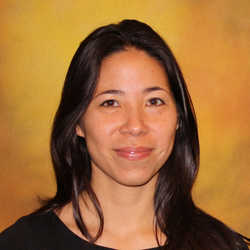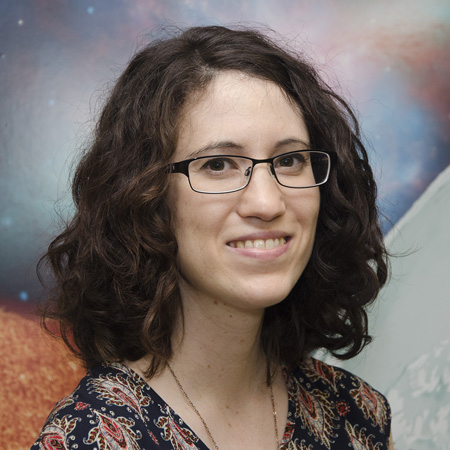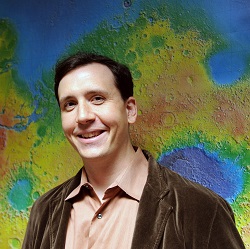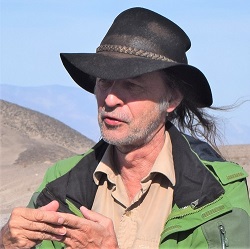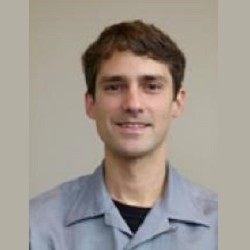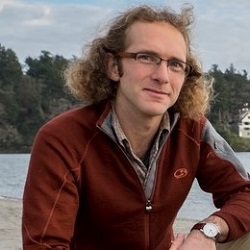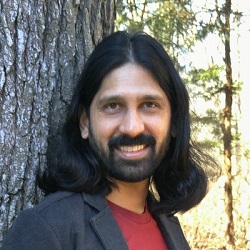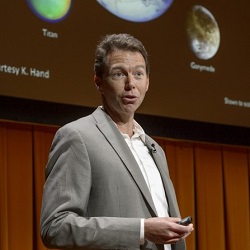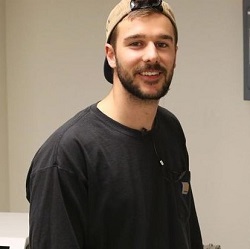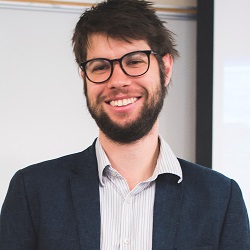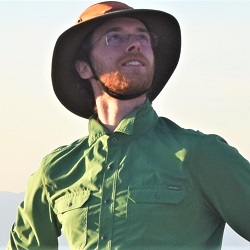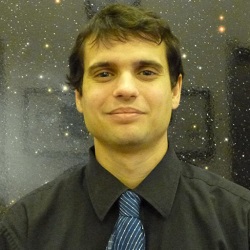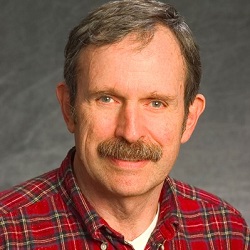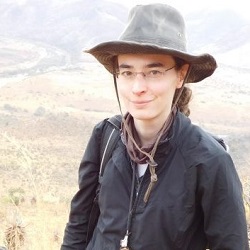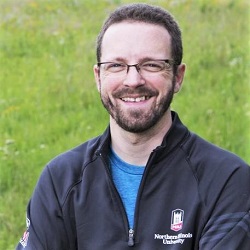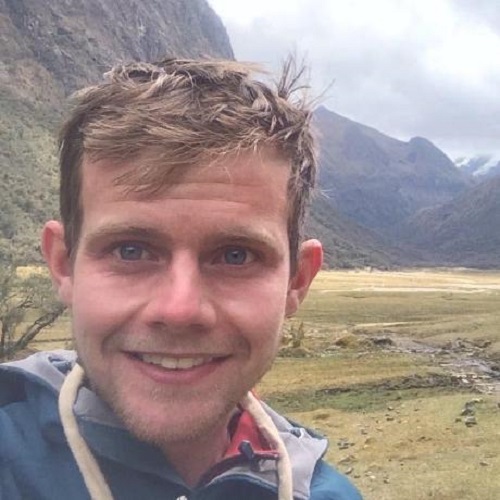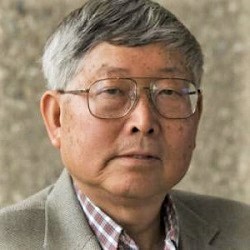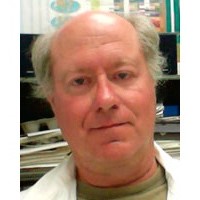
Early Earth provides multiple examples of other kinds of habitable planets very different from our modern world that may help to guide interpretation of observations of planets elsewhere in the galaxy. VPL research has generated major advances in understanding our early planet. The Earth Through Time research area combines geological and biological data with ecosystem and climate models to help us determine how Earth’s environment has changed throughout its history. By constraining parameters like surface temperature, atmospheric pressure, and composition, and determining corresponding biogeochemical cycling and greenhouse effects, we can explore a range of ecosystems dominated by many different metabolisms very different from those found on modern-day Earth. Since life co-evolves with its environment, the coupled study of life and its environment throughout history may provide insight into ancient habitability and the possibility of life on other worlds.
VPL has already contributed significantly to our understanding of this long-term co-evolution of the Earth and its biosphere, including the development of tools that we are continually improving. We have developed photochemical models (e.g., Zerkle et al., 2012, Claire et al 2014), atmospheric escape models, weathering models (Bolton et al., 2006), climate models (Roberson et al., 2011), spectral models of the ancient Sun (Claire et al., 2012), and coupled biology-nutrient cycling models (Claire et al., 2006).
Together, these models allow us to constrain the likely biological productivity and climates of these environments, and simulate planetary spectra that are self-consistent with these environments and metabolisms. We have used these models to interpret various Archean environments, including a haze-rich Mesoarchean and Neoarchean atmosphere (Domagal-Goldman et al., 2008; Haqq-Misra et al., 2009, Kurzweil et al 2013, Claire et al 2014, Izon et al 2015, Arney et al 2016), the “faint young Sun” paradox in the Proterozoic (Roberson et al., 2010), and biological productivity in the Archean (Claire et al., 2006; Kharecha, et al., 2005).
Geochemical constraints on the early Earth environment are necessary to construct models and understand the habitability of our early planet, and VPL has led the community in many aspects of these efforts. We have worked to understand the alkalinity of Archean lakes (Stüeken et al 2015a) and the redox state of ancient seas (Stüeken et al 2015b). We study how ancient life operated, too. For example, VPL research has considered when oxygenic photosynthesis evolved (Buick et al 2008)and when oxygen’s first traces hit the atmosphere (Anbar et al 2007, Krissansen-Totton et al 2015), VPL research shows how nitrogen isotope evidence indicates organisms were able to use atmospheric N2 as a nitrogen source as early as 3.2 billion years ago (Stüeken et al 2015c). We also study nitrogen from the perspective of a bulk atmospheric gas: studies of fossilized raindrop imprints have provided constraints on the total Archean atmospheric pressure (Som et al 2012, Kavanagh et al 2015). Paleomagnetic analyses suggest that atmospheric circulation patterns at 3.5 billion years ago were similar to today, and ancient Earth had a dipole magnetic field (Bradley et al 2015).
The study of Earth’s history provides us with a variety of plausible environments and metabolisms to consider, and by simulating planetary spectra for these unique cases, around stars of various spectral types, we can begin to catalog a range of biosignatures we may potentially detect with exoplanet characterization missions such as JWST and TPF (see also Tasks D and E).
Specific scientific highlights from The Earth Through Time where VPL has led the field are given below:
The Many Impacts Of Haze On The Archean Planet
VPL has pioneered studies on the potential for organic haze in the Archean atmosphere. Understanding atmospheric haze on our planet is important because hazy Archean Earth may be the most “alien” world for which we have geochemical data. The Archean haze would have profoundly affected our planet’s environment with impacts ranging from cooling of the climate to acting as a possible UV shield for surface life.

VPL researcher J. Haqq-Misra led a study on the weakened greenhouse potential for methane on Archean Earth (Haqq-Misra et al. 2008) due to its ability to form haze at CH4/CO2 ratios approximately greater than 0.1. Another pioneering study of Archean haze was led by VPL researcher S. Domagal-Goldman, investigating the coupling of haze to sulfur isotope signatures in the geologic record (Domagal-Goldman et al. 2008). Subsequent studies involving VPL team members have sought geochemical evidence for this haze. The seminal study by Zerkle et al. (2012) uncovered correlations between sulfur isotopes and organic carbon isotopes from sediments collected from the Ghaap Group in South Africa, suggesting an important connection between these sulfur signatures and biogenic methane production. Subsequent photochemical analyses by Kurzweil et al. (2013) and Claire et al. (2014) have given us a more detailed look at how sulfur photochemistry can be impacted by an atmospheric haze, and additional geochemical evidence collected by Izon et al. (2015) has expanded the links between sulfur isotopes and biogenic methane over multiple geological cores over multiple locations, suggesting global impact of haze in the late Archean. More recently Arney et al. (2016) performed a new study of the impact of fractal haze on the habitability and spectrum of the planet, and these updated results suggest that hazes are not incompatible with habitable surface temperatures. The spectral signatures of such a haze are strong, both in reflected light and transit transmission.
The Nitrogen Story
VPL researchers have led the way in understanding nitrogen on Earth from biochemical, geochemical, and observational perspectives. Nitrogen is a key nutrient for all life on Earth, but the process by which N2 in the atmosphere is converted to forms used by life forms is complex. A major breakthrough came when E. Stüeken, R. Buick, and colleagues (Stüeken et al. 2015c) analyzed N isotopes in Archean sediments and showed that the processes by which biology incorporates nitrogen had evolved as early as 3.2 billion years ago. This study is synergistic with a separate work by E. Stüeken, R. Buick, and colleague (Stüeken et al. 2015a) showing that Archean lakes were likely alkaline environments based on nitrogen isotope data. The VPL team’s work on biological nitrogen incorporation has significant implications for the amount of N in Earth’s atmosphere. Studies by VPL members have provided critical insights to the total amount of nitrogen in Earth’s ancient atmosphere. Studies of fossilized raindrop imprints have placed constraints on the total Archean atmospheric pressure (Som et al 2012, Kavanagh et al 2015). Finally, we have examined the nitrogen content of the bulk Earth in Johnson et al. (2015), concluding that the bulk silicate Earth contains roughly 7 times the present amount of atmospheric nitrogen.

Clues From Trace Elements
VPL members have led the field in understanding how trace elements leave big clues about the ancient planet’s environment. A spike in selenium weathering support a brief “whiff” of oxygen during the Archean prior to the “Great Oxygenation Event” (Stüeken et al 2015d). This has implications for atmospheric chemistry, continental weathering, and the chemistry of the oceans at the time. This has led to work on the ability of selenium to participate in novel biosignatures species and participate in a global selenium cycle (Stüeken et al 2015b). A vitally important trace element for life on Earth is phosphorous, and research involving VPL member R. Buick reports on the occurrence of phosphite in Archean marine carbonates, suggesting that this species was an abundant component of the oceans before 3.5 billion years ago (Pasek et al 2013). VPL members have also been involved with important work considering sulfur isotopes as indicators of past environments, particularly in respect to possible Archean hazy intervals (Kurzweil et al 2013, Farquhar et al 2013, Claire et al 2014 Izon et al 2015).

The Role Of Clouds In Early Earth Climate
The team published two papers (Goldblatt and Zahnle, 2011a and 2011b) that studied the effects of clouds on the early Earth’s climate. This is relevant to the “faint young sun paradox,” which is the juxtaposition of expectations that the sun was dimmer early in Earth’s history with geological evidence for a climate at least as warm as today’s. One of the largest uncertainties in models of this time is clouds which could have caused either warming or cooling on early Earth. We conducted a major parametric study, in which we fully explored the phase space of changing clouds, understanding their radiative forcing and allowing objective evaluation of the forcing from various hypothesized changes to clouds (Goldblatt and Zahnle, 2011a). For example, we responded rapidly (Goldblatt and Zahnle, 2011b) to a high profile proposal by Rosing et al. (2010) that less low cloud would resolve the faint young sun paradox, showing that this was not quantitatively plausible. We also showed that a long-standing assumption in early Earth climate models that clouds could be neglected from the atmosphere and replaced with an enhanced surface albedo leads to a systematic over-estimate of the strength of greenhouse gas forcings. A spin-off application of our work on Earth was in astronomy; we were able to show that representing clouds in brown dwarf stars as having partial coverage (cloudy and cloud free sub-columns in a single-column model) gave a much better fit to observed spectra than existing models (Marley et al., 2010).


Click to See Researchers Working on This Task
Email: randerson@carleton.edu Website CV VPL Focus: Task B
Bio: I’m an assistant professor at Carleton College in the Biology department. The overarching goal of my research is to understand how life co-evolves with its environment over time. We use next-generation sequencing tools to better understand the processes that drive microbial and viral evolution over time. We collaborate with astronomers, geologists, chemists, and atmospheric scientists to ask big-picture questions in astrobiology and oceanography. My work with VPL focuses on the analysis of phylogenetic trees to better constrain when specific microbial metabolisms were radiating across the tree of life. I collaborate with geochemists to corroborate these findings with the geochemical record. Our hope is to better understand which microbial metabolisms were most important at specific points in Earth’s history and to connect that with possible observable biosignatures.
Email: giada.n.arney@nasa.gov
Website:
CV / Publications: https://science.gsfc.nasa.gov/sed/bio/giada.n.arney
VPL Focus: Task A, Task B (Lead), Task E
Bio:
My research has involved modeling and measuring properties of planets with an emphasis on worlds enshrouded by global cloud and haze layers because aerosols appear to be a common planetary phenomeon. I have a dual focus on both solar system bodies and on exoplanets. I have retrieved properties of Venus’ sub-cloud atmosphere through observations of its nightside spectral windows, producing the first simultaneous and temporally resolved maps of cloud opacity, acid concentration, water vapor (H2O), hydrogen chloride (HCl), carbon dioxide (CO), carbonyl sulfide (OCS), and sulfur dioxide (SO2). I also have extensive modeling experience of planetary atmospheres and have comprehensively simulated hazy Archean Earth with a coupled photochemical-climate model to study its atmospheric composition, climate, and habitability. Using a sophisticated radiative transfer model together with a coronagraph noise model and a JWST model, I showed that organic haze on an Earthlike planet produces strong spectral signatures that may be detectable with future telescopes. In addition, I helped lead a paper on Proxima Centauri b’s possible climatic and environmental states and their spectral discriminants, and I have been involved in work identifying oxygen false positive biosignature signals. My current and near-future research focuses on modeling the atmospheric and climatic states of exoplanets, understanding the observational requirements to discriminate between different planetary states with current and future observatories, and re-visiting Venus with new observations.
Email: shawn.goldman@nasa.gov
VPL Focus: Task B (Lead), Task D, Task E
Bio:
Shawn Domagal-Goldman in a Research Space Scientist in the Planetary Environments Laboratory at NASA’s Goddard Space Flight Center in Greenbelt, MD. He is an astrobiologist that focuses on comparative planetology. As a member of multiple interdisciplinary teams, he simulates the atmospheres of other worlds, including those of ancient Earth, modern Mars, ancient Mars, and exoplanets. He utilizes the outputs from those simulations to interpret data from some of Earth’s most ancient rocks, from the Mars Curiosity rover, and to simulate the capabilities of future space-based telescopes designed to look for life on exoplanets. Shawn is a collaborator by nature, and a member of many research and mission teams, including the Curiosity science team, the HabEx Science and Technology Definition Team, the Large UV-Optical-Infrared Surveyor (LUVOIR) Study Office, is on multiple research teams in the Nexus for Exoplanet Systems Science (NExSS).
Email: jbaross@uw.edu
VPL Focus: Task B
Bio:
John Baross is a Professor in Oceanography and the Astrobiology Program at the University of Washington. He specializes in the ecology, physiology, and taxonomy of microorganisms from hydrothermal vent environments, and the use of biochemical and molecular methods to detect, quantify, and classify the same. John has particular interests in the microbial ecology of extreme environments, the biotechnological applications of microorganisms that grow in extreme environments, astrobiology, and in the significance of submarine hydrothermal vent environments for the origin and evolution of life. The novel environment and microbes present at Lost City are of great interest to John and his laboratory group. Samples recovered from this field offer potential for new discoveries and insights into life in the extreme environments of hydrothermal vents.
Email: buick@ess.washington.edu
VPL Focus: Task B
Bio:
I am interested in the origin and earliest evolution of life on Earth and how that can be used as an analogue for life elsewhere in the Universe. My research techniques lie at the intersection of geology, biology and chemistry, examining the oldest and best-preserved rocks available. This involves fieldwork in the Australian outback, on the Greenland ice-cap and in the Canadian woods, amongst other places.
Examples of current projects include:
Early evolution of bacterial metabolism – palaeontology and stable-isotope geochemistry of Archaean sedimentary rocks, with the aim of determining when the main forms of microbial metabolism first arose and whether this caused environmental change in the atmosphere and oceans.
Early Archaean atmospheric composition – detrital heavy minerals in Archaean fluvial sandstones, with the aim of determining whether their alteration patterns indicate primordial atmospheric greenhouse effect modulated by carbon dioxide or some other gas in order to counteract the weaker solar luminosity during Earth’s early history.
Secular trends in marine nutrient fluxes and their ecological impact – phosphorus and nitrogen geochemistry in sedimentary rocks through time, with the aim of betterquantifying oceanic fluxes and budgets for these elements, identifying temporal trends in their sources and sinks, and determining whether these reflect or influenced ecosystem evolution.
Early evolution of continental crust – trace-element and radiogenic-isotope geochemistry of basalts ~3.5 billion years old across an ancient unconformity in the Pilbara Craton, Australia, with the aim of contraining the primordial growth rate of continental crust, the tectonic environments of the early Earth and the biological impacts of crustal differentiation.
Molecular fossils from early Precambrian rocks – organic geochemistry of well-preserved Archaean and Palaeoproterozoic hydrocarbons and kerogen, with the aim of discovering organic geochemical biomarkers that constrain the phylogenetic history of microbial ecosystems.
Selected Publications:
2012: Som, S.M, Catling, D.C., Harnmeijer, J.P., Polivka, P.M. & BUICK, R. Air density 2.7 Gyr ago limited to less than twice modern levels by fossil raindrops. Nature, 484, 359-362.
2012: Stüeken, E.E., Catling, D.C. & BUICK, R. Contributions to late Archaean sulphur cycling by life on land. Nature Geoscience, 5, 722-725.
2011: Summons, R.E., Amend, J.P., Bish, D.L., BUICK, R., Cody, G.D., Des Marais, D.J., Dromart, G., Eigenbrode, J.L., Knoll, A.H. & Sumner, D.Y., Preservation of Martian organic and environmental records: final report of the Mars Biosignature Working Group. Astrobiology, 11, 157-181.
2009: Garvin, J., BUICK, R., Anbar, A.D., Arnold, G.L. & Kaufman, A.J., Isotopic evidence for an aerobic nitrogen cycle in the latest Archean. Science, 323, 1045-1048.
2008: BUICK, R., When did oxygenic photosynthesis evolve? Philosophical Transactions of the Royal Society B, 363, 2731-2743.
2007: Anbar, A.D., Duan, Y., Lyons, T.W., Arnold, G.L., Kendall, B., Creaser, R.A., Kaufman, A.J., Gordon, G.W., Scott, C., Garvin, J. & BUICK, R., A whiff of oxygen before the Great Oxidation Event. Science, 317, 1903-1906.
2007: Kaufman, A.J., Johnston, D.T., Farquhar, J., Masterton, A.L., Lyons, T.W., Bates, S., Anbar, A., Arnold, G.L., Garvin, J. & BUICK, R., Astrobiological insights into global biospheric oxygenation and atmospheric evolution. Science, 317, 1900-1903.
2001: Shen, Y., BUICK, R. & Canfield, D.E., Isotopic evidence for microbial sulphate reduction in the early Archaean era. Nature, 410, 77-81.
1999: Brocks, J.J., Logan, G.A., BUICK, R. & Summons, R.E., Archean molecular fossils and the early rise of eukaryotes. Science, 285, 1033-1036.
1998: Dutkiewicz, A., Rasmussen, B. & BUICK, R., Oil preserved in fluid inclusions in Archaean sandstones. Nature, 395, 885-888.
Email: dcatling@u.washington.edu
VPL Focus: Task B, Task D
Bio:
After a doctorate in the Dept. of Atmospheric, Oceanic and Planetary Physics at the University of Oxford, England, I worked as a planetary scientist near San Francisco at NASA’s Ames Research Center from 1995-2001. In 2001, I joined the faculty at the University of Washington in Seattle. I also had a stint as European Union Marie Curie Chair in Earth and Planetary System Science at the University of Bristol, England, from 2005-2008, while also an affiliate professor at the University of Washington.
Currently, I’m a Professor jointly appointed to the Dept. of Earth and Space Sciences and cross-campus Astrobiology Program at the University of Washington. My research interests revolve around understanding the co-evolution of planetary atmospheres, planetary surfaces, and life. This includes collecting and interpreting data from other planets and the Earth. A key goal is to understand the habitability of planets in general. I have also been involved in NASA’s exploration of Mars and was part of a 35-person team of scientists responsible for NASA’s Phoenix Mission, a probe that landed and operated successfully in the northern polar region of Mars in 2008. I am author of the book, Astrobiology: A Very Short Introduction— a readable and up-to-date summary of the subject. I also have co-written a technical book aimed at researchers and PhD students entitled Atmospheric Evolution on Inhabited and Lifeless Worlds.
For more info on research, check out my publications.
Email: benjamin.charnay@lmd.jussieu.fr
VPL Focus: Task B, Task C, Task E
Bio:
My research topic is the physics and dynamics of planetary atmospheres. I have been focussing on the dynamics of Titan’s troposphere and the climates of the early Earth. Now, I am also studying the atmospheres and climates of exoplanets (i.e. dynamics, photochemistry, clouds and haze). I study these atmospheres with 3D Global Climate Models (GCMs).
Research interests:
- Titan’s troposphere (dynamics, planetary boundary layer, surface winds and dune formation)
- Climatic evolution of Titan
- Climates of the early Earth (faint young Sun problem and formation of organic haze)
- Habitability of exoplanets
- Exoplanetary atmospheres (super-Earths and Neptune-size planets)
Email: mc229@st-andrews.ac.uk
VPL Focus: Task B, Task C
Bio:
I work on improving models of terrestrial planets, with the aim of reducing uncertainties in our ability to interpret spectra of extrasolar planets. I work with the VPL photochemical and climate models, and am broadly interested in questions of atmospheric evolution and planetary habitability.
Selected publications:
Claire, M.W. , Sheets, J., Cohen, M., Ribas, I., and Catling, D.C., “The evolution of solar flux from 2 nm to 160 microns: quantitative estimates for planetary studies” Astrophysical Journal, in press, 2012.
Zerkle A., Claire M., Domagal-Goldman S., Farquhar J., and Poulton S. “A bistable organic-rich atmosphere on the Neoarchaean Earth, Nature Geosciences, 2012. DOI: 10.1038/NGEO1425.
Domagal-Goldman, S.D., Meadows, V.C, Claire, M.C., Kasting, J.F. “Astronomical biosignatures for sulfur-rich anoxic biospheres.” Astrobiology, 11(5), 2011.
Beal, E., Claire, M, and House, C.. “High rates of anaerobic methanotrophy at low sulfate concentration with implications for past and present methane levels” Geobiology, DOI: 10.1111/j.1472-4669.2010.00267.x, 2011.
Tian, F., Claire, M., Haqq-Misra, J., Smith, M.,Crisp, D., Catling, D., Zahnle, K., Kasting, J. . “Photochemical and climate consequences of sulfur outgassing on early Mars.” Earth and Planetary Sciences Letters, 295 (3-4), 412-418, 2010.
Catling, D.C., Claire, M. W., Zahnle, K. J., Quinn, R. C., Clark, B. C., Hecht, M. H., Kounaves, S. “Atmospheric origins of perchlorate on Mars and in the Atacama”, J. Geophys. Res., 115,E00E11, 1-15, 2010
Marion, G.M., Catling, D.C., Zahnle, K.J., and Claire, M.W. “Modeling aqueous perchlorate chemistries with applications to Mars”, Icarus, 207 (2) 675-685, 2010.
Goldblatt C., Claire, M. , Lenton, T. , Matthews, A., Watson, A., Zahnle, K. “Nitrogen-enhanced greenhouse warming on the early Earth” Nature Geosciences, 2 (12), 891-896, 2009.
Catling, D.C., Claire, M.W., and Zahnle, K.J., “Anaerobic methanotrophy and the rise of atmospheric oxygen” Philosophical Transactions of the Royal Society of London – A, 365, 1867-1888, 2007.
Mix, L. J. et al., “The Astrobiology Primer: An Outline of General Knowledge – Version 1, 2006”, Astrobiology, 6 (5),735-813, 2006.
Claire, M.W., Catling, D.C., and Zahnle, K.J., “Biogeochemical modeling of the rise in atmospheric oxygen” Geobiology, 4, 239-269, 2006.
Zahnle, K.J., Claire, M.W., and Catling, D.C. “The loss of mass-independent fractionation in sulfur due to a Paleoproterozoic collapse of atmospheric methane” Geobiology, 4, 271-283, 2006.
Catling, D.C and Claire, M.W., “How Earth’s atmosphere evolved to an oxic state – A status report” , Earth and Planetary Sciences Letters – Frontiers, 237, 1-20, 2005.
Email: bwj@iastate.edu
VPL Focus: Task B
Bio:
I am an Earth System scientist, geologist and geochemist. My work seeks to understand the evolution of the Earth over deep time and how it can serve as context for newly discovered exoplanets. Utilizing geochemical, geologic, and modeling techniques I have investigated the history of the Earth system nitrogen cycle, microbial activity during Snowball Earth, and volatile cycling on our planet.
Email: mkipp@caltech.edu
VPL Focus: Task B
Bio:
I’m a Postdoctoral Fellow in the Division of Geological & Planetary Sciences at Caltech. My research involves using geochemical tools to unravel the co-evolution of life and its planetary environment across our planet’s history. The topics I study range from the oxygenation of the atmosphere & ocean to the evolution of major nutrient (N & P) cycles to recent climatic perturbations.
Email: koehlerm@uw.edu
VPL Focus: Task B
Bio:
I’m a biogeochemist, exploring the co-evolution of life and environments on the early Earth! My DESKTOP background is a leafy seadragon.
Email: jkt@ucsc.edu
VPL Focus: Task A, Task B
Bio:
I am a planetary scientist and astrobiologist from New Zealand, currently living in San Jose. You can read more about my scientific background here. I am a theoretician, and so the pictures below are thoroughly unrepresentative of my day job!
Email: olehmer@uw.edu
VPL Focus: Task B, Task D
Bio:
My research focus is on modeling the formation, evolution, and detection of habitable planets in an effort to find and characterize the next Earth-like planet.
Email: eschwiet@ucr.edu
VPL Focus: Task A, Task B, Task D
Bio:
I’m a member of the UCR Alternative Earths Team at the University of California, Riverside. My supervisor is Dr. Timothy Lyons. I’m also a member of the Virtual Planetary Laboratory. My research interests and activities include studying Earth as an exoplanet (throughout geologic time), determining planetary properties from disk-integrated spectra, climate, photochemical, and radiative transfer modeling of terrestrial planet atmospheres, and generating synthetic spectra of model exoplanets. I’m particularly interested in work that can inform our ability to characterize Earth-sized planets that reside in the habitable zones of their host stars, especially in search of remotely detectable biosignatures.
Email: ees4@st-andrews.ac.uk
VPL Focus: Task B
Bio:
I am interested in the origin and early evolution of life and environments on Earth and implications for the habitability of other planets. My tools include sedimentary geology, stable isotopes (carbon, nitrogen, sulphur, selenium) and transition metal geochemistry. I am also keen to apply these tools to better understand ore-forming processes through time and space.
Email:
VPL Focus: Task B
Bio:
My research focuses on three approaches to tackle the central challenges in analyzing complex environmental communities: 1) to develop novel computational techniques to inform a new generation of genomic and community genomic data; 2) to model the co-evolution of organisms and the environment; and 3) to illuminate the evolutionary origin and history of phenotypes and environmental adaptation.
Email: wogan@uw.edu
VPL Focus: Task B, Task D
Bio:
Nick is a graduate of the University of Oregon where he majored in Physics
His past research has focused on Electromagnetic geophysics, Seismology, and Geodynamics and his future research interests include thermodynamics and disequilibrium biosignatures
In his free time Nick enjoys climbing mountains and then skiing down them! And you might find this interesting, but Nick has never tasted Pepsi or Coke.
